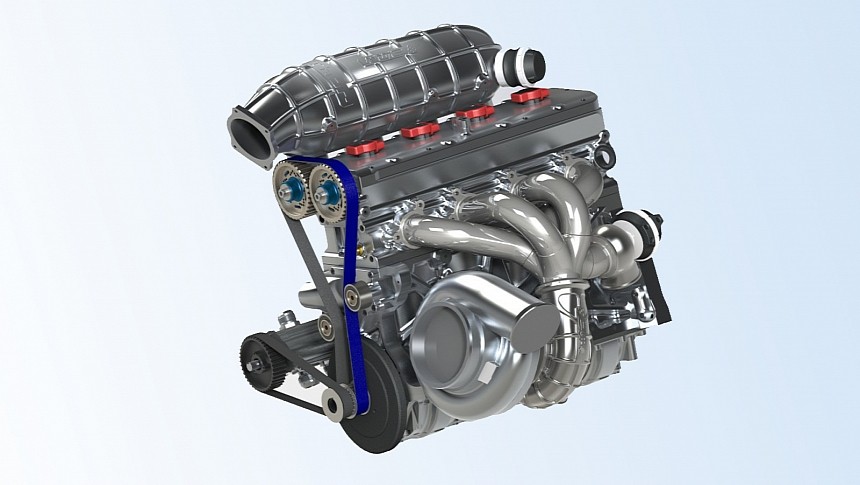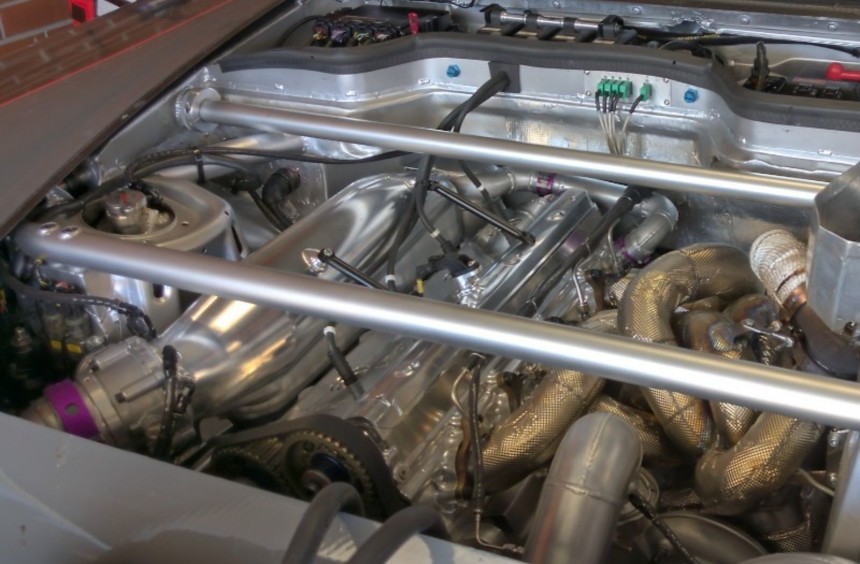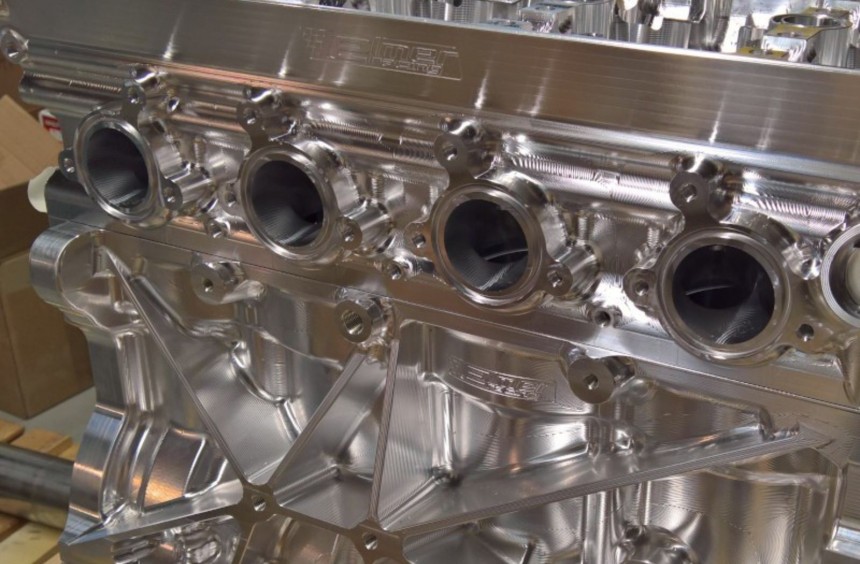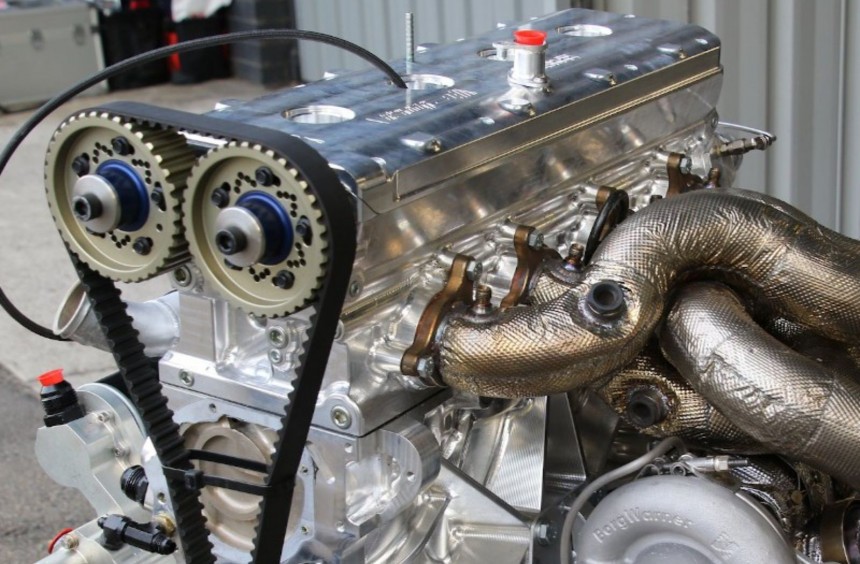Dubbed the world's first full-billet circuit racing engine, the THOR V2 might not be street-legal, but it's one of the most outrageous turbocharged four-cylinders ever developed.
Among hardcore car nuts that refuse to jump on the electric bandwagon, the inline-four continues to be grossly underrated. Though countless examples of street and competition fours capable of delivering plenty of power have been developed during the last four decades, enthusiasts still have a special place in their hearts for engines with more than six cylinders - preferably arranged in a V configuration.
Nevertheless, it's hard to ignore four-cylinder icons. When I hear "competition inline-four," I usually think about the BMW E30 M3's naturally-aspirated S14, which made close to 400 hp in competition-spec back in the 1980s, or its distant, turbocharged sibling, the 1,350-hp M12/13 which is still considered the most powerful Formula 1 engine of all time, more than forty years after its debut.
But there are also highly-tuned, drag- or drift-spec versions of engineering masterpieces like Mitsubishi's 4G63T, Nissan's SR20DET, or GM's 2.2 Gen II Ecotec that have been taken close to 1,000-hp on stock blocks. We can even go back to the 1970s when turbocharged Offys dominated the Indy 500, so there are many examples of rabid four-cylinders that can hang with the big boys.
However, there's always that V8-loving enthusiast who points out that a competition four-cylinder can't make the same outrageous amounts of power as a similar V8. While that's in many ways true, Elmer Racing's rabid Thor V2 is here to shatter any preconceived notions about the potential and limits of a four-pot, making a long list of competition V8s look like lawnmower engines.
It's no secret that a race engine has to offer the optimal balance between weight and power. In specific race classes where displacement, power output, and overall weight are limited, the engine configuration doesn't really matter, and it's often predetermined by the rulebooks.
However, in specific motorsport competitions with no real limits, like Time Attack, using the right engine configuration is critical to striking the perfect power-to-weight ratio.
A correctly tuned V8 can easily deliver massive horsepower, but what if you can extract the same amount of ponies from a smaller and, more importantly, lighter inline-four?
Impossible, right? Well, not for the Finnish experts at Elmer Racing, who have been working on a turbocharged four-cylinder monster fittingly named Thor for about a decade.
The first iteration, rated well past the 1,500-hp mark, was finished in 2017. Five years and many championship titles later, the engineering wizards blessed the racing community with an even more impressive second version.
Tipping the scales at just 330 pounds (150kg) fully equipped and displacing 4.0 liters, Thor V2 is about as light as possible for an inline-four of its size. In fact, the company claims that the powerplant has a better power-to-weight ratio than any OEM racing engine ever built - including those used in Formula 1.
This was made possible by fabricating both the V2's long block and cylinder head out of solid pieces of ultra-high-quality billet. As any serious tuning buff can attest, a billet-machined block or head is not only lighter than a similar cast-aluminum component but also a lot more durable. It's even more durable than beefy cast iron units like those of the 2JZ, Barra, or 4G63T - legendary blocks which can withstand massive power in stock form.
Though loosely based on the architecture of Porsche's iconic M44 engine, the Thor V2 was entirely developed and upgraded in-house by Elmer Racing. To complement the billet architecture, it received lightweight and high-quality, race-bred internals.
The fabulous four-cylinder can be set up for disciplines like Time Attack or Hillclimb. In this standard configuration, it displaces 4.0 liters and produces up to 2,000 hp.
There's also a second configuration tailored for drag racing. In this case, the Thor V2 is bored up to 4.4 liters, and the power potential goes up to no less than 3,000 hp.
Elmer Racing states that the $112,462 (€101,680) package includes the Thor V2 equipped with a dry sump lubrication system, an oil pump, and a proprietary vibration damper. Buyers must use their desired manifolds (although the company can provide their own versions), electronics, and turbo. Speaking of which, the engine is designed to put out the abovementioned output figures and rev up to 10,500 RPM using a single-turbo setup. Moreover, further customizations that address gearbox/bell housing customizations are possible.
So, if you have the money, can you order the Thor V2 and use it on your track day project? Well, the short answer is no. Elmer Racing specifies that the company will only take orders from professional racing teams with the required knowledge to build, race, and maintain the unit. It is by no means a crate engine, but if you're a retired race engineer with bottomless pockets who wants to show off at the track on weekends, you might convince the Finns to sell you one.
In the meantime, you can see the Thor V2 in action during the World Time Attack Championship, where it powers the reigning champions PRTech's lethal RP968 Porsche.
If you would like to learn more about this terrific engine, we recommend watching the YouTube video below.
Nevertheless, it's hard to ignore four-cylinder icons. When I hear "competition inline-four," I usually think about the BMW E30 M3's naturally-aspirated S14, which made close to 400 hp in competition-spec back in the 1980s, or its distant, turbocharged sibling, the 1,350-hp M12/13 which is still considered the most powerful Formula 1 engine of all time, more than forty years after its debut.
But there are also highly-tuned, drag- or drift-spec versions of engineering masterpieces like Mitsubishi's 4G63T, Nissan's SR20DET, or GM's 2.2 Gen II Ecotec that have been taken close to 1,000-hp on stock blocks. We can even go back to the 1970s when turbocharged Offys dominated the Indy 500, so there are many examples of rabid four-cylinders that can hang with the big boys.
However, there's always that V8-loving enthusiast who points out that a competition four-cylinder can't make the same outrageous amounts of power as a similar V8. While that's in many ways true, Elmer Racing's rabid Thor V2 is here to shatter any preconceived notions about the potential and limits of a four-pot, making a long list of competition V8s look like lawnmower engines.
The idea behind this fantastic powerplant
However, in specific motorsport competitions with no real limits, like Time Attack, using the right engine configuration is critical to striking the perfect power-to-weight ratio.
A correctly tuned V8 can easily deliver massive horsepower, but what if you can extract the same amount of ponies from a smaller and, more importantly, lighter inline-four?
Impossible, right? Well, not for the Finnish experts at Elmer Racing, who have been working on a turbocharged four-cylinder monster fittingly named Thor for about a decade.
The first iteration, rated well past the 1,500-hp mark, was finished in 2017. Five years and many championship titles later, the engineering wizards blessed the racing community with an even more impressive second version.
A lightweight yet bombproof construction
This was made possible by fabricating both the V2's long block and cylinder head out of solid pieces of ultra-high-quality billet. As any serious tuning buff can attest, a billet-machined block or head is not only lighter than a similar cast-aluminum component but also a lot more durable. It's even more durable than beefy cast iron units like those of the 2JZ, Barra, or 4G63T - legendary blocks which can withstand massive power in stock form.
Though loosely based on the architecture of Porsche's iconic M44 engine, the Thor V2 was entirely developed and upgraded in-house by Elmer Racing. To complement the billet architecture, it received lightweight and high-quality, race-bred internals.
Available in two main configurations
There's also a second configuration tailored for drag racing. In this case, the Thor V2 is bored up to 4.4 liters, and the power potential goes up to no less than 3,000 hp.
Elmer Racing states that the $112,462 (€101,680) package includes the Thor V2 equipped with a dry sump lubrication system, an oil pump, and a proprietary vibration damper. Buyers must use their desired manifolds (although the company can provide their own versions), electronics, and turbo. Speaking of which, the engine is designed to put out the abovementioned output figures and rev up to 10,500 RPM using a single-turbo setup. Moreover, further customizations that address gearbox/bell housing customizations are possible.
So, if you have the money, can you order the Thor V2 and use it on your track day project? Well, the short answer is no. Elmer Racing specifies that the company will only take orders from professional racing teams with the required knowledge to build, race, and maintain the unit. It is by no means a crate engine, but if you're a retired race engineer with bottomless pockets who wants to show off at the track on weekends, you might convince the Finns to sell you one.
In the meantime, you can see the Thor V2 in action during the World Time Attack Championship, where it powers the reigning champions PRTech's lethal RP968 Porsche.
If you would like to learn more about this terrific engine, we recommend watching the YouTube video below.











